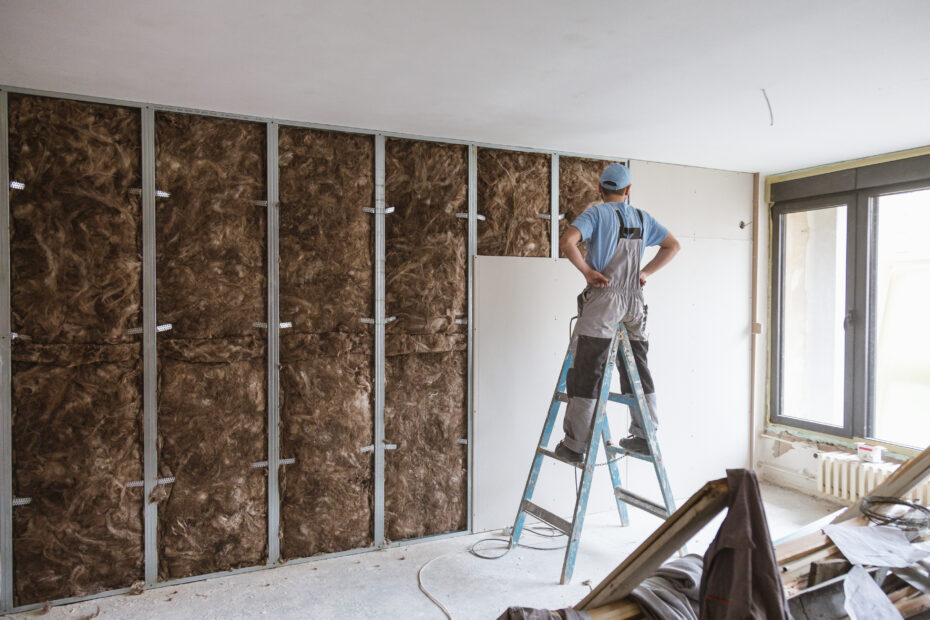Drywall is a flexible building material used for covering walls and ceilings. It comes in a variety of constructions, including mould-resistant, plasterboard, VOC-absorbing, and other types.
Before World War I, most homes used plaster to finish their walls. After the war, there was demand for a faster method to finish walls and drywall was developed. Today, it is the preferred finish material for interior walls.
What is Drywall, exactly?
Drywall can be used as a covering material for ceilings and walls. It is made of gypsum (a naturally occurring mineral, in abundance) and is an eco-friendly choice. The gypsum mixture is combined with additional materials to make a “slurry”, which is sandwiched between layers of paper and dried. The type and thickness of the paper along with the chemicals in slurry will determine the type of drywall.
Drywall can also refer to gypsum board and wallboard as well as Sheetrock.
Drywall can be used to provide soundproofing, fire resistance and soundproofing in walls and ceilings within residential or commercial buildings. It is screwed onto the framing, and the joints between drywall panel panels are taped. Next, mud will be applied to smoothen out the transitions, and to repair the screw holes. Once dry, the mud can be sanded to a fine finishing and then the wall can either be painted or texture.
Drywall Thickness
Drywall can come in many thicknesses and be used in various applications. Multi-layer drywall can be used to increase fire resistance or soundproofing.
1/4 inch is the thinnest size of wallboard, and it is used mostly on curved walls. Because of its thinness, it’s more flexible than regular drywall, especially when wet. It’s ready to be painted like regular drywall when it’s dry.
The most common thickness of drywall is 1/2 in. This is used for most walls in commercial and residential construction. It provides fire protection for 30 minutes. Multiple layers may be used in areas or rooms that require greater protection.
5/8 inch drywall provides soundproofing and more fire resistance. It can provide 60 minutes of fire protection and can often be used in layers for additional protection.
6 Common Types of Drywall
There are many types of drywall. They can be distinguished by the colour and paper that surrounds it. These variations can be caused by different types of paper or the addition chemicals to the slurry.
1. Regular Drywall
Regular drywall is often called whiteboard and used for ceilings and walls in both residential and commercial properties. For residential purposes, the thickness most used is 1/2 inches. While the most common size for drywall sheets is 4′ x 8, it’s also possible to order it in lengths of up to 16′ for tall ceilings. For small repairs and easy transport, 2’x2″ drywall sizes are sold by home improvement shops.
2. Mould-resistant Drywall
Mould-resistant or green board drywall is made with a thicker paper backing than regular drywall. The wax coating provides extra moisture resistance. A non-organic fiberglass mesh (called paperless) is included. It removes anything that could cause mould growth. Most commonly, mould-resistant drywall can be used in bathrooms, kitchens, laundry areas, and as a tile backing. You can also purchase mould-resistant clay. Please note that moisture resistance drywall may not be the same as mould resistant.
3. Plasterboard
Plasterboard, also known as blue board, can be used as a foundation for plaster applications. This is like the lath in plaster walls or lath. Plasterboard will require a thin layer of plaster to cover the entire surface. The plaster finish coating will adhere better to the plaster face paper, which is absorptive. It is often used in older homes for the plaster-like appearance.
4. Soundproof Drywall
Although all drywall has soundproof qualities, soundproof drywall adds wood fibres, gypsum, or polymers to increase the sound transmittance class (STC), above regular drywall. STC, a rating that indicates how much noise a material can absorb. Soundproof drywall may be used when soundproofing is not enough, for example between living spaces or shared walls. It is harder to work in than regular drywall because it is denser.
5. Fire-resistant Drywall
The specialized fire-resistant drywall is used around equipment that might start a fire. It contains fiberglass, which slows down the fire’s progress and doesn’t burn as fast than regular gypsum. Type X and type C are both fire-resistant drywalls. Type X can provide up to an hour protection from fire and is only 5/8 inches thick. It can be used in layers to provide additional protection if required. Type C is the exact same as Type X and doesn’t shrink in flames. It’s used primarily to keep ceilings from collapsing during a flame.
6. VOC-absorbing Drywall
VOC-absorbing drywall is a relatively novel product. It captures chemicals and other volatile organic compounds and traps them within the wall, making them inert. These chemicals can be found in other building materials as well as everyday cleaning products. The drywall is durable even when it has been painted or covered by a light wall covering. It can last up to 75 years.
